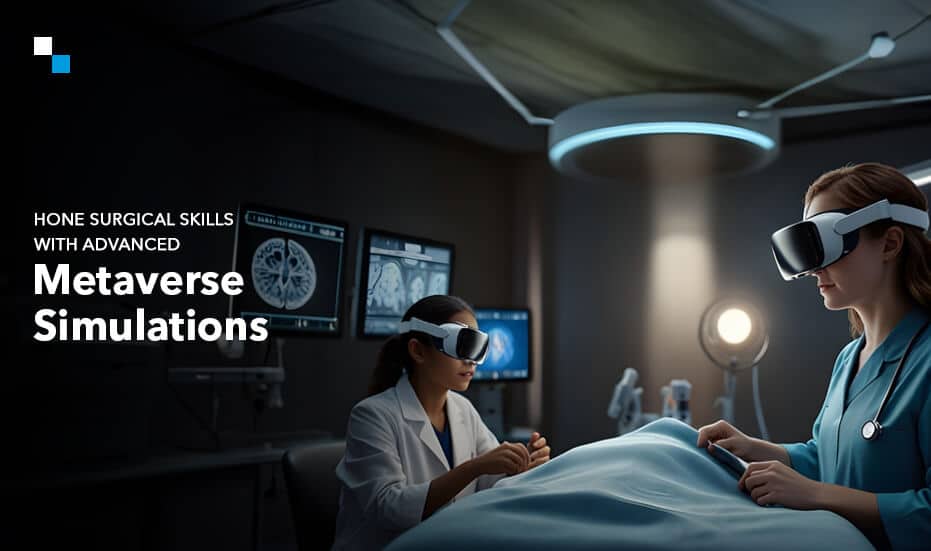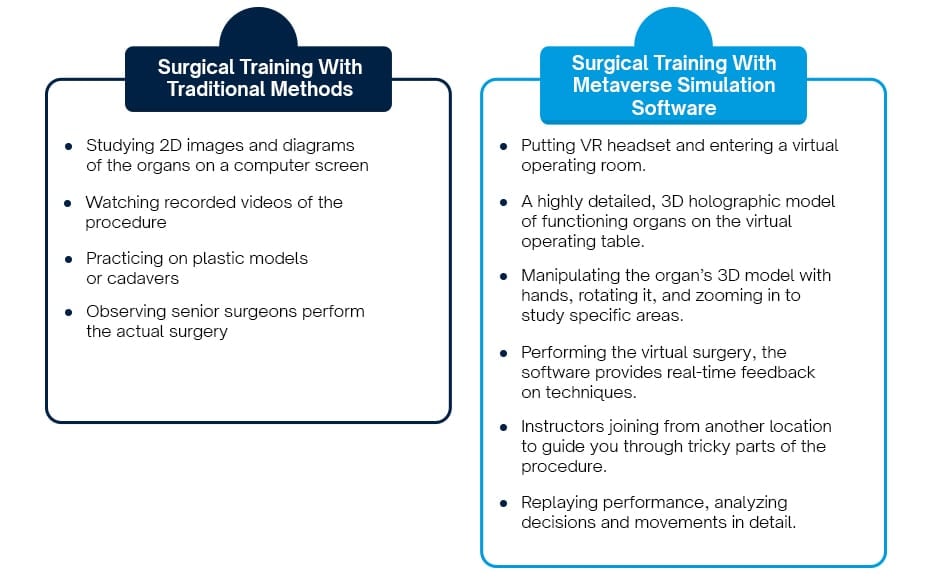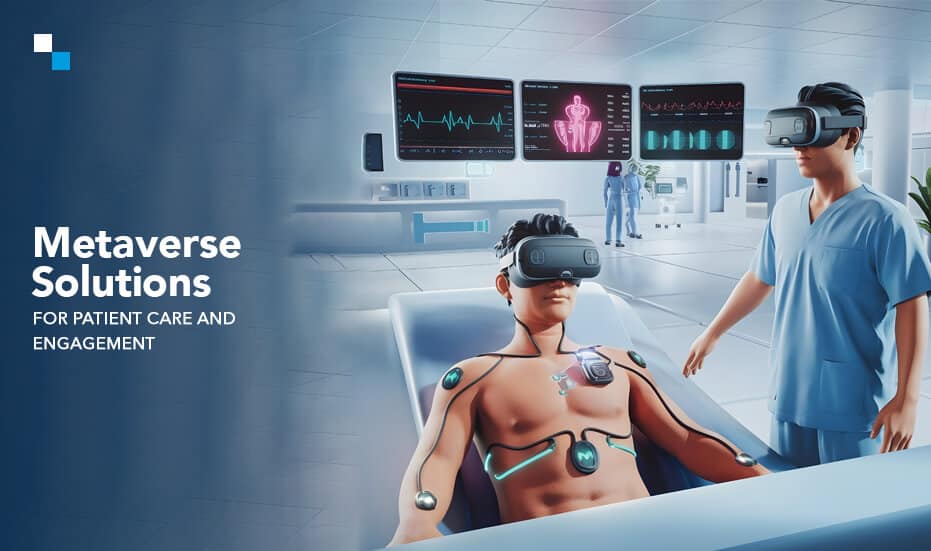
How GameFi Brings an Excellent Solution to Key Challenges Faced by Blockchains
September 18, 2024
ERC-721 & ERC-1155 – How They Influence NFT Development
September 18, 2024The rise of the Metaverse has paved the way for profound and simultaneous changes in multiple aspects of our lives, including advancements in medical training and education. The Metaverse in Medical Education is a collective virtual space that creates a realistic, immersive environment for medical professionals to practice complex procedures without patient involvement. Simulated Medical Education and training not only enhances learning opportunities, but contributes to better healthcare outcomes by making them more precise, preventative, and supportive. Simulation software improves surgical perceptions by guiding through the critical steps of interventions. This guide will walk you through the use of Metaverse simulations in healthcare, highlighting their groundbreaking uses, remarkable benefits, and their ability to improve the quality of healthcare.
Do you know?
MarketsandMarkets reports state that the global medical simulation market is expected to reach $3.7 billion by 2026, growing at a CAGR of 15.2% from 2021 to 2026.
The Use of Metaverse Simulation Software in Medical Training
Medical training using photorealistic images on monitors is now a thing of the past. This approach was not only time-consuming but also inefficient for solo practice. Metaverse has now introduced more collaborative methods to train professionals with 3D representations of body organs directly projected onto surgical fields. This advancement enables surgeons to gain relevant insights, learn more effectively, diagnose faster, and make informed operational decisions.
With Simulated Medical Education, surgeons can practice the surgery countless times in a safe, realistic environment, and get reports according to the performance. They can collaborate with experts from around the world using Multiplayer mode and experience rare surgical scenarios that they may not see during their regular training.
This shares a great experience of understanding the tools handling while learning the accurate procedure before going into the actual surgery.

Key Technologies Behind Metaverse Healthcare Simulations
Healthcare simulations are leveraging advanced rendering techniques, haptic feedback systems, and AI-driven scenarios to replicate real-world medical situations with unprecedented fidelity.
- High-fidelity 3D modeling: Used to create the accurate representation of Medical equipment and human anatomy through Photogrammetry techniques and Advanced 3D modeling.
- Real-time rendering engines: Deliver low-latency and high-quality visual experiences through gaming engines like Unreal and Unity.
- Haptic feedback systems: Stimulate the texture, and provide realistic tactile sensations through Fore-feedback devices and microfluidic technology for touch and resistance in Surgical training.
- AI and machine learning algorithms: Contributes to virtual patients, and real-time performance analysis.
- Cloud computing: Provide access to big medical databases within the virtual setting.
- BCID: Interprets brain signals to execute commands, and provides neurofeedback for skills training. This helps to simulate cognitive loads experienced during complex procedures.
- Volumetric rendering: Derived from CT or MRI scans, it enables the surgical trainees to interact with 3D representations of patient-specific anatomy.
- Physics-based tissue simulation: This is used to replicate the behavior of different tissue types during surgical procedures through advanced algorithms
Do you know?
The University of California San Francisco has developed a VR surgical training platform that combines high-resolution 3D modeling with haptic feedback. Their system uses a custom physics engine that simulates tissue deformation and fluid dynamics in real time, achieving a refresh rate of 90 Hz to maintain immersion and prevent motion sickness.

Real-time Skill Assessment and Feedback in Virtual Simulations
The AI-powered analytics in Simulated Medical Education software enables Medical institutions to continuously assess the performance of their surgeon trainees. Hospitals can use the technology to prepare the next generation of surgeons, offering an unprecedented level of precision, objectivity, and effectiveness in skill development and assessment. These systems leverage multiple data streams to provide comprehensive evaluation and feedback, which involves:
1. Motion Tracking
By using Computer vision algorithms, medical institutes can analyze trainees’ hand movements and surgical techniques in real time: This involves:
- High-precision optical or electromagnetic tracking systems that capture hand and instrument positions with sub-millimeter accuracy.
- Machine learning models that compare trainee movements to databases of expert surgeons’ techniques and provide feedback.
Key metrics include:
- Movement efficiency (path length, smoothness)
- Instrument handling (angle, force applied)
- Spatial accuracy about anatomical structures
2. Procedural Analysis
Providing immersive education can help to evaluate decision-making and protocol adherence using Natural Language Processing and expert systems. This can help the institutions and hospitals to ensure that there is:
- Adherence to surgical checklists and safety protocols.
- Appropriateness of decisions at key procedural milestones.
Expert systems compare trainee actions to predefined optimal procedure flows.
3. Biometric Monitoring
By using wearable sensors integrated into VR headsets, medical institutions can track physiological indicators in trainees like stress and focus during the surgical procedure. This includes:
- Eye-tracking: Pupil dilation, gaze patterns, and focus points.
- Heart rate variability and electrodermal activity to monitor stress.
- Electromyography to measure muscle fatigue in extended procedures.
4. Adaptive Simulation Environments
The AI-powered adaptive stimulation environments enable Medical Institutions to adjust training scenarios based on real-time performance data. They can change the level of complexities based on skill level. This can contribute to:
- Target challenge generation: Create scenarios focused on identifying weaknesses
- Complicated simulation: Introduction of the rare events or complications to test the decision-making of practicing surgeons.
5. Performance Visualization and Reporting
Hospitals can use Data visualization tools to provide intuitive feedback to trainees and instructions. With Machine learning models analyzed, medical institutions can performance data of trainees over time.
Learning curve model that helps to predict skill development trajectories. It also contributes to the early identification of trainees who may require additional support.
Reduce The Training Costs and Improve Retention With Metaverse Healthcare Simulation Tools
While the Metaverse platform for medical education contributes to better surgical outcomes and diagnoses the patient better, it also significantly removes the surgeon training cost. Hospitals can take advantage of AI algorithms to create diverse, realistic patient scenarios by:
- Replacing expensive physical cadavers with highly detailed 3D models for anatomy training.
- Creating diverse medical scenarios at a fraction of the cost of physical simulations.
- Implementing AI-driven learning algorithms to optimize skill retention through personalized practice schedules.
- Using the social VR frameworks like VRChat or AltspaceVR to create shared learning spaces.
- Implementing Dynamic Physiological models to stimulate the complex body systems to reflect realistic patient responses to treatments.

The Benefits of Metaverse Simulations in Healthcare
1. Safe, Risk-free Environments for Practice
Metaverse simulations provide a safe space for medical professionals to hone their skills without risking patient safety. This can help to:
- Perform Rare or high-risk procedures that require repetitive practice of complex surgeries or emergency scenarios.
- Identify and address potential mistakes in a consequence-free environment.
- Improve performance under stress by exposing trainees to high-pressure situations to build resilience.
2. Accelerated Learning and Skill Development
Medica professionals can speed up the trainee learning process by:
- Using machine learning algorithms to adjust the complexity of scenarios based on the learner’s performance.
- Engaging trainees in multiple senses to enhance information retention and skill acquisition.
- Providing real-time guidance and performance metrics for trainees for instant improvement.
“A study published in the journal Surgical Endoscopy found that medical residents trained using VR simulations achieved proficiency in laparoscopic cholecystectomy procedures 29% faster than those trained using traditional methods”
3. Bridging Gaps in Healthcare Access and Education
The Metaverse simulations can enable medical professionals to guide trainees about surgical procedures or provide patients with consultations from anywhere around the world, without facing limitations like physical space or lack of equipment. They can use the AI to create real-alike scenarios reflecting the diverse patients and medical cases.
Enhance Your Healthcare Training with Antier’s Metaverse Simulation Software
Integrate Metaverse Simulation tools for advanced medical training and patient care with Antier. Our Metaverse Platform for Medical Education leverages photorealistic and AI-driven digital twins to offer immersive, risk-free environments where future surgeons can perfect their skills. Use biometric monitoring to detect early signs of cybersickness for timely interventions and adjustments.
Get expert guidance from our developers to integrate high fidelity virtual sinulation tools into your current medical practices for providing surgeons with realistic, hands-on training. Enhance the quality of medical education, promote remote learning, and improve overall patient outcomes by offering complex procedure practice in a safe, controlled setting.
Partner with Antier today to drive excellence in Medical training and outcomes!




